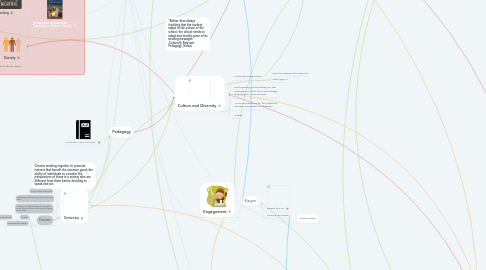
1. Citizens working together to promote interest that benefit the common good; the ability of individuals to consider the perspectives of those in a society who are different from them before deciding to speak and act.
2. Curriculum
2.1. Social Skills
2.2. Communication
2.3. Academics
2.4. Leadership
3. United States School Sytem
3.1. State
3.1.1. State Board of Education
3.1.2. Curriculum, Policy, Graduation Requirements, Standards
3.2. Local
3.2.1. School Board
3.2.2. Work with their Communities
3.2.3. Employ Superintendent, Budget, Oversee Facility Issues, Bargaining
3.3. Federal
3.3.1. Department of Education
3.3.2. Emergency Response System
4. Mainetnance and Operation
5. Individualized
6. National Administration for Educational Excellence and Equal Access
7. Knowledge
7.1. Memory
7.2. Nonlinguistic
7.2.1. Images
7.2.2. Models
7.2.3. Mental Pictures
7.2.4. Pictures, Illustrations, and Pictographs
7.2.5. Kinesthetic Activities
7.3. Linguistic
7.3.1. Words
8. Promote Student Achievement
9. Introduction to Education: Teaching in a Diverse Society
9.1. Teaching
9.1.1. Intrinsic
9.1.2. Appreciation
9.1.3. Extrinsic
9.1.4. Salary
9.1.5. Effectiveness
9.2. Diversity
9.3. Personal and Cultural Styles
10. Pedagogy
10.1. "The function or work of a teacher"
11. Democracy
11.1. Social Justice and Equity
11.2. Questioning whether you are on the right track
11.3. "It doesn't matter what we are going to cover, what matters is what you are going to discover"
11.4. Dewey
11.4.1. Change
11.4.1.1. Direct Experience
11.4.2. New areas for research
12. Happiness
12.1. Emotionally Intelligent Teachers
12.2. Be Present
12.2.1. Connect deeply with others
12.2.1.1. Take time for positive experiences
12.2.1.1.1. Feel your negative feelings
13. School Policy
13.1. Age of learner
13.1.1. Expectations of Completion
13.1.1.1. Relationship between homework and grades
13.1.1.2. Comments rather than grades
13.1.1.2.1. Participation points
13.1.1.3. Summative Practice (speed and accuracy): Graded
13.1.2. Increase speed, accuracy, fluency, and conceptual understanding
13.1.3. Short, focused, and distributed over time
13.2. 10 min X grade level
14. Relationships
15. Cooperative Learning
15.1. Individual Accountability
15.2. Formative & Summative Assessments
15.3. Positive Interdependence
15.4. =
15.5. Instruction
15.5.1. "Explain Why..." "What is the difference between..."
15.5.1.1. Cueing and Questioning
15.5.1.2. Inferential
15.5.1.2.1. Draw upon what students already know
15.5.1.3. Activate Prior Knowledge
15.5.1.3.1. Graphic Organizers
15.5.1.3.2. Make it clear to students what they are going to learn and focus on what is important
15.5.1.3.3. Explicit Cues
15.5.1.3.4. Advance Organizers
15.5.1.4. Analytic
15.5.1.4.1. Prompt students to think deeply and critically
15.5.2. or Less in Groups
15.5.3. Structure
15.5.4. Skill
15.5.5. Collaboration
15.5.6. Creativity
15.5.7. Art-Form
15.5.8. Media
15.5.8.1. Web 1.0
15.5.8.1.1. Web 2.0
15.5.8.1.2. "Read and write"
15.5.8.1.3. Facebook, Myspace, Youtube
15.5.8.2. 1st generation of web, Front page/Common entry point, "Read only"
15.5.9. Modeling
15.5.9.1. Guidance
15.5.9.1.1. "Move beyond "right answer learning" and toward application of learning"
16. Types of Schools
16.1. Private
16.2. Public
17. Classroom Instruction that Works
17.1. Meta-analyses
17.1.1. 1998 Study: Average of 22 years for students to lean typical k-12 curriculum
17.2. Goals and Objectives
17.2.1. Mastery-Goal Orientation
17.3. Communication
17.3.1. Connect to Personal Experience and Previous and Future Learning
17.3.2. Feedbaack to Students and Parents
17.4. Motivation
17.4.1. Reinforce Effort
17.4.2. Decreased Behaviors
17.5. Assessment
17.5.1. Teacher
17.5.1.1. Student
17.5.1.1.1. Parents
17.5.2. Self
17.5.2.1. Reflection
18. Culture and Diversity
18.1. Culturally Responsive
18.1.1. Need to be prepared at the college level
18.1.2. Teacher prep 3.0
18.2. Recognizing and building on the strengths and funds of knowledge that exist in communities
18.3. Accommodations for the different asssets and needs of students
18.4. Safety
19. "Rather than always inisisting that the student adapt to the culture of the school, the school needs to adapt and modify some of its sending messages" -Culturally Relevant Pedagogy (Video)
20. Engagement
20.1. Kagan
20.1.1. Everyone has a turn
20.1.2. Interactive pair and team
21. Homework
21.1. Mixed evidence that shoes increase in student achievement
21.2. Overt Practice: flash cards and labeling
22. Similarities and Differences
22.1. Existing to new
22.2. Comparing
22.2.1. Classifying
22.2.1.1. Creating metaphors
22.2.1.1.1. Creating analogies
22.2.1.1.2. Relationships between relationships
22.2.1.1.3. A:B::C:D
22.2.1.2. Finding 2 topics that appear to be different but have the same general pattern
22.2.1.3. A Rainbow in Our Garden: flowers are the same color as the rainbow
22.2.1.4. Chart or metaphor pattern diagram
22.2.2. Organizing things into groups and labeling according to similarities
22.2.3. Explain why an item belongs in a specific category
22.2.4. Chart or circle diagram
22.3. Similarities among things or ideas
22.4. Explain how things are different
22.5. Venn diagrams
23. Grading
23.1. Reflection of what students know against the standards
24. Microlectures
25. Differentiation
25.1. Continuous Progress - Lifelong learners
25.1.1. Accommodations for EACH student
25.1.1.1. Grouping students by ability not age
25.1.1.1.1. Flexibility
25.1.1.1.2. Student choices
25.1.1.2. Effective Teacher Planning
25.1.1.3. Preassessment is key
25.1.1.4. Stations
25.1.1.4.1. Brainteasers
25.1.1.4.2. 1. With teacher 2. Without teacher 3. Partner
25.1.2. Learning opportunities are matched to child's level
25.1.3. Fairness- YES!
25.2. Standards of Excellence
25.2.1. Challenging
25.2.2. Student makes an Increase of 1 grade level each year
26. Five Key Classroom Elements for teachers to understand and plan wisely for
26.1. Curriculum
26.1.1. Assessent
26.1.1.1. Instruction
26.1.1.1.1. Classroom Management
26.1.2. Formative
26.1.2.1. Summative
26.1.2.2. Given at the end of a unit
26.1.3. Given often throughout a unit

